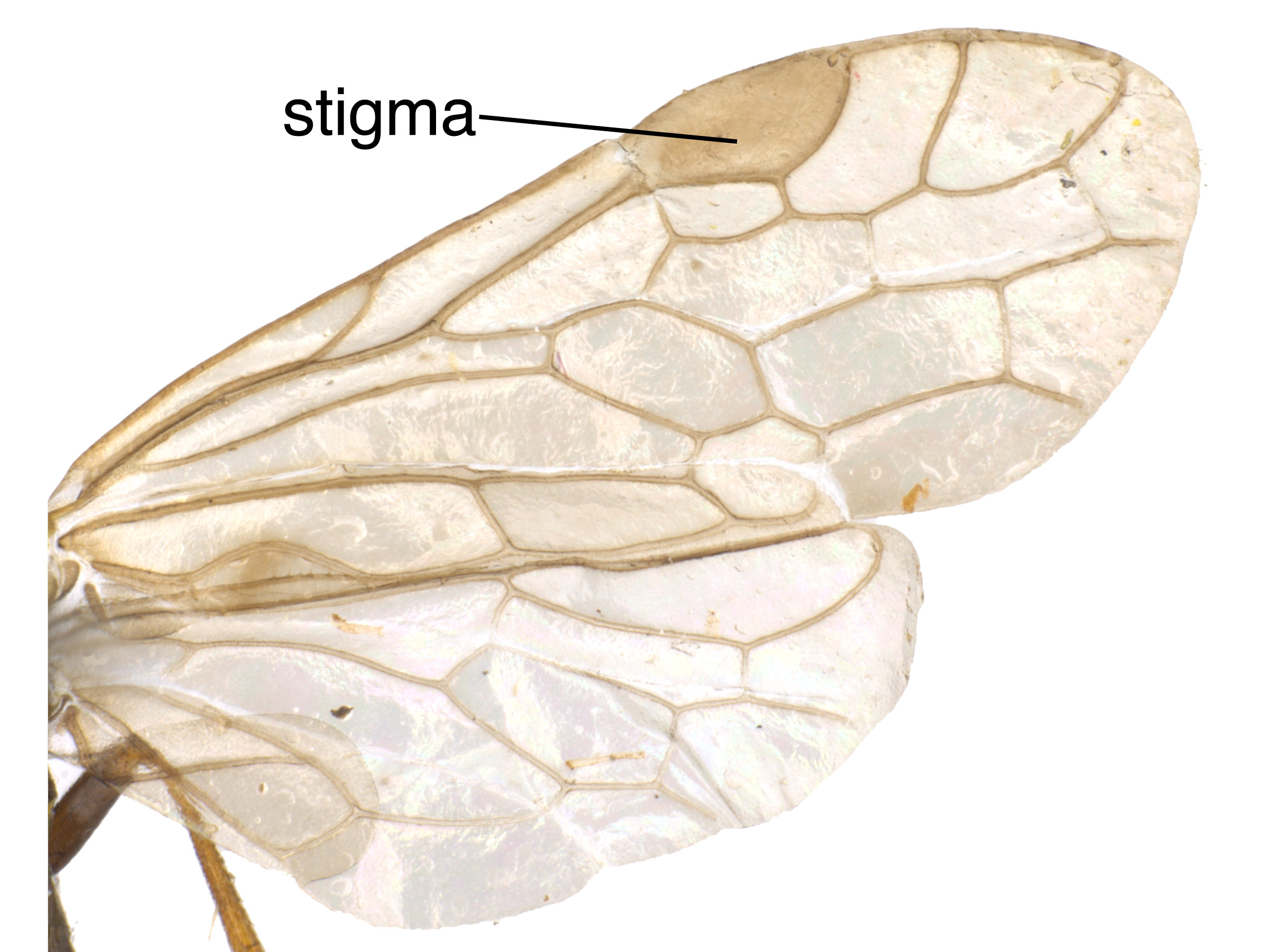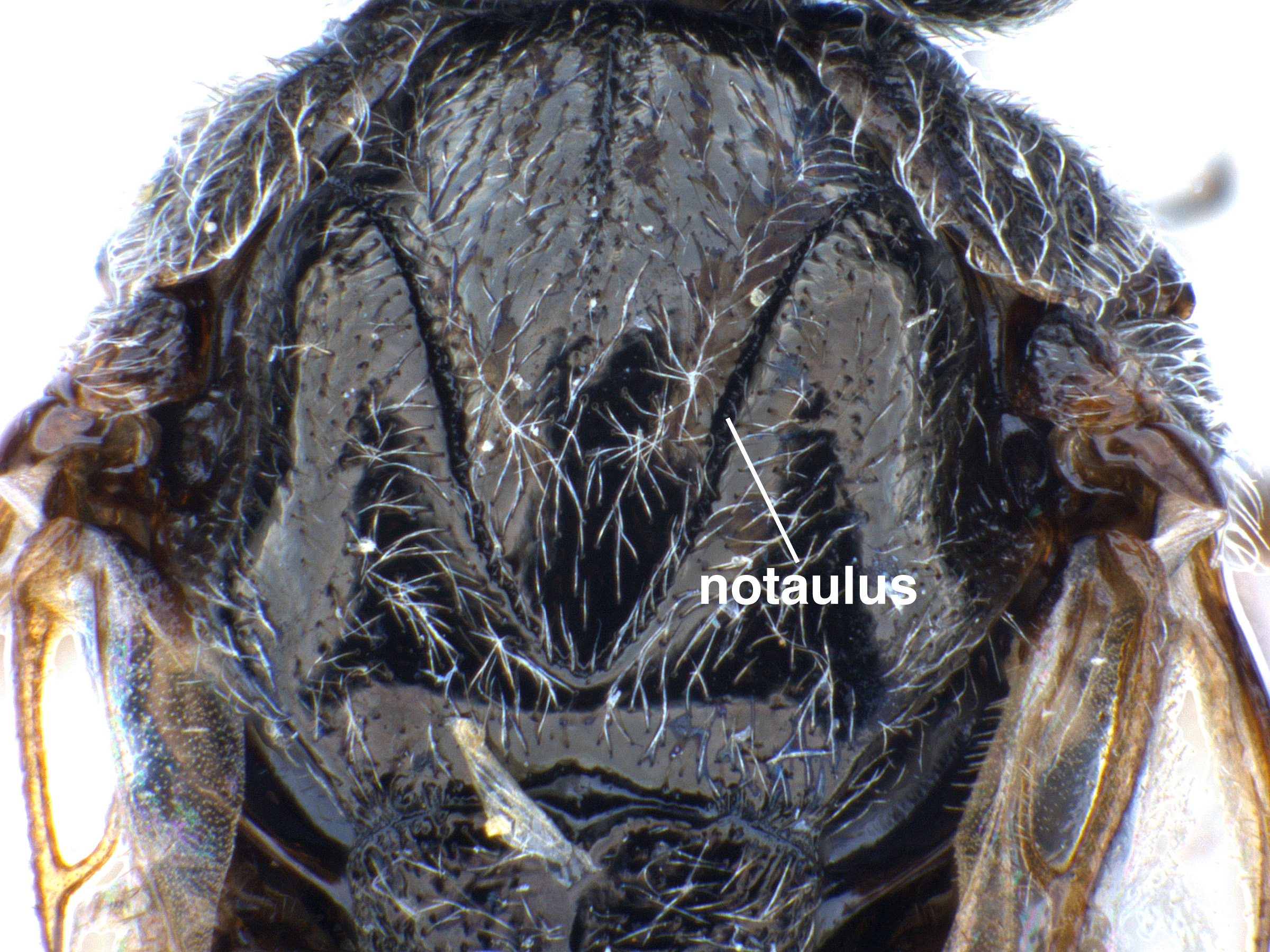Family: Tenthredinidae
Family common name: common sawflies
Subfamily: Nematinae
Tribe: Pseudodineurini
Genus: Pseudodineura Konow, 1885
Subgenera: none
The Tenthredinidae are the most species-rich family and are found throughout the world, in all continents but Antarctica. They are known as the “common sawflies.” They can generally be recognized by a cylindrical body and long, segmented antennaeantenna:
the sensory organ emerging from the front of the head, usually between the compound eyes and above the clypeus; includes the flagellum, scape and pedicel
 . Otherwise, they come in a variety of colors, sizes, and forms (Goulet 1992Goulet 1992:
. Otherwise, they come in a variety of colors, sizes, and forms (Goulet 1992Goulet 1992:
Goulet H. 1992. The genera and subgenera of the sawflies of Canada and Alaska: Hymenoptera. Symphyta. The insects and arachnids of Canada. Part 20. Agriculture Canada Publication.).
Nematinae is the second-largest subfamily of Tenthredinidae, with over 1250 species (Prous et al. 2014Prous et al. 2014:
Prous M, Blank SM, Goulet H, Heibo E, Liston A, Malm T, Nyman T, Schmidt S, Smith DR, Varing;rdal H, Viitasaari M, Vikberg V, and Taeger A. 2014. The genera of Nematinae (Hymenoptera, Tenthredinidae). Journal of Hymenoptera Research 40: 1-69. " target="_blank">https://doi.org/10.3897/JHR.40.7442). They are most diverse in northern Eurasia and North America; only a few species occur in the Southern Hemisphere. Nematinae sawflies have a variety of feeding habits including external leaf feeding, leaf mining, and gall forming, and feed on a variety of hosts (Smith 2003bSmith 2003b:
Smith DR. 2003b. A Synopsis of the sawflies (Hymenoptera: Symphyta) of America south of the United States: Tenthredinidae (Nematinae, Heterarthrinae, Tenthredininae). Transactions of the American Entomological Society 129 (1): 1-45.).
The Nematinae have been subject to numerous revisions in recent years. As of 2021, there are no comprehensive keys to many of the North American species of Nematinae (Prous et al. 2014Prous et al. 2014:
Prous M, Blank SM, Goulet H, Heibo E, Liston A, Malm T, Nyman T, Schmidt S, Smith DR, Varing;rdal H, Viitasaari M, Vikberg V, and Taeger A. 2014. The genera of Nematinae (Hymenoptera, Tenthredinidae). Journal of Hymenoptera Research 40: 1-69. " target="_blank">https://doi.org/10.3897/JHR.40.7442). Because of changing taxonomy and extreme variability in morphology, identifying genera and species in the Nematinae may be more challenging than in other subfamilies of Tenthredindae. For this reason, knowing the host or behaviors of a specimen can be extremely helpful for identification within this subfamily.
Pseudodineura is a rare genus of small sawflies, about 4–5 mm in length found in northern ranges. Most species are black with red or yellow striping on the legs (Smith 1976bSmith 1976b:
Smith DR. 1976b. World genera of the leaf-mining sawfly tribe Fenusini (Hymenoptera: Tenthredinidae). Insect Systematics and Evolution 7: 253-260.).
There are 10 described species worldwide. Five species occur in North America (Taeger et al. 2018Taeger et al. 2018:
Taeger A, Liston AD, Prous M, Groll EK, Gehroldt T, and Blank SM. 2018. ECatSymmdash;Electronic World Catalog of Symphyta (Insecta, Hymenoptera). Program version 5.0 (19 Dec 2018), data version 40 (23 Sep 2018). Senckenberg Deutsches Entomologisches Institut (SDEI), Muuml;ncheberg. https://sdei.de/ecatsym/ Accessed: 28 Jan 2020.).
A key to North American species is included in Smith 1976bSmith 1976b:
Smith DR. 1976b. World genera of the leaf-mining sawfly tribe Fenusini (Hymenoptera: Tenthredinidae). Insect Systematics and Evolution 7: 253-260..
Subfamily characters
 (Goulet 1992Goulet 1992:
(Goulet 1992Goulet 1992: vein 2A+3A incomplete and straight (Prous et al. 2014Prous et al. 2014:
vein 2A+3A incomplete and straight (Prous et al. 2014Prous et al. 2014: vein 2m-cu meeting cellcell:
vein 2m-cu meeting cellcell: 1Rs or 2Rs above, interstitial with or very close to crossveincrossvein:
1Rs or 2Rs above, interstitial with or very close to crossveincrossvein:Genus characters
 with posterior margin positioned anteriorly of anterioranterior:
with posterior margin positioned anteriorly of anterioranterior: (Ross 1937Ross 1937:
(Ross 1937Ross 1937: vein 2r-m sometimes absent (Prous et al. 2014Prous et al. 2014:
vein 2r-m sometimes absent (Prous et al. 2014Prous et al. 2014:Pseudodineura may be confused with other genera in the subfamily Nematinae—especially those with fore wingfore wing:
the anterior wing of each pair of wings; usually the largest wing of the pair
 vein 2r-rs present and veinvein:
vein 2r-rs present and veinvein:
a tube-like, often darkened, structure on the wings
 2m-cu meeting cellcell:
2m-cu meeting cellcell:
1. a membranous area of the wing between veins, 2. a small cavity or closed space
 2Rs—but can be distinguished from most genera by the incomplete hind winghind wing:
2Rs—but can be distinguished from most genera by the incomplete hind winghind wing:
the posterior wing of each pair of wings
 vein 2A (some species of Pristiphora also have this veinvein:
vein 2A (some species of Pristiphora also have this veinvein:
a tube-like, often darkened, structure on the wings
 incomplete, but can be distinguished by their indistinct notaulinotaulus:
incomplete, but can be distinguished by their indistinct notaulinotaulus:
one of a pair of diverging furrows on the mesoscutum
 ). Pseudodineura can be distinguished from the closely related genus Kerita by the fine pits on the postocularpostocular:
). Pseudodineura can be distinguished from the closely related genus Kerita by the fine pits on the postocularpostocular:
describes area behind the compound eye
region of the head (Goulet 1992Goulet 1992:
Goulet H. 1992. The genera and subgenera of the sawflies of Canada and Alaska: Hymenoptera. Symphyta. The insects and arachnids of Canada. Part 20. Agriculture Canada Publication.) and by the position of the ocelliocellus:
a simple bead-like eye, often on the dorsum of the head in groups of 1-3
 (Ross 1937Ross 1937:
(Ross 1937Ross 1937:
Ross HH. 1937. A generic classification of the Nearctic sawflies (Hymenoptera, Symphyta). University of Ilinois Bulletin 34 (94): 1-173.).
Pseudodinerua enslini and P. mentiens in Europe are minor pests to landscaping plants. The plants are generally not severely damaged, but the leaf mines can make the plants unsightly as ornamentals and floral production can be reduced (Liston et al. 2019bListon et al. 2019b:
Liston AD, Prous M, and Varing;rdal H. 2019b. The West Palaearctic Pseudodineura and Endophytus species (Hymenoptera, Tenthredinidae). Zootaxa 4614 (3): 511-528.).
Pseudodineura feeds on species of Hepatica (liverleaf) and Ranunculus (buttercup) (Goulet 1992Goulet 1992:
Goulet H. 1992. The genera and subgenera of the sawflies of Canada and Alaska: Hymenoptera. Symphyta. The insects and arachnids of Canada. Part 20. Agriculture Canada Publication.).
Larvae are leaf miners (Smith 1976bSmith 1976b:
Smith DR. 1976b. World genera of the leaf-mining sawfly tribe Fenusini (Hymenoptera: Tenthredinidae). Insect Systematics and Evolution 7: 253-260.). When disturbed, Pseudodineurini larvaelarva:
the immature stage of holometabolous insects
 secrete the compound citral, which repels ants. Presumably this is a beneficial defense strategy when they leave the mine to overwinter or pupate in the soil (Boevé et al. 2009).
secrete the compound citral, which repels ants. Presumably this is a beneficial defense strategy when they leave the mine to overwinter or pupate in the soil (Boevé et al. 2009).
World: The genus is known from North America, and from Europe in the United Kingdom east through Central and Eastern Europe into Russian Siberia (Smith 1976bSmith 1976b:
Smith DR. 1976b. World genera of the leaf-mining sawfly tribe Fenusini (Hymenoptera: Tenthredinidae). Insect Systematics and Evolution 7: 253-260., Taeger et al. 2018Taeger et al. 2018:
Taeger A, Liston AD, Prous M, Groll EK, Gehroldt T, and Blank SM. 2018. ECatSymmdash;Electronic World Catalog of Symphyta (Insecta, Hymenoptera). Program version 5.0 (19 Dec 2018), data version 40 (23 Sep 2018). Senckenberg Deutsches Entomologisches Institut (SDEI), Muuml;ncheberg. https://sdei.de/ecatsym/ Accessed: 28 Jan 2020.)
North America: Pseudodineura has three ranges in North America. Three species occur in the northeastern United States and Canada west to Alberta, and one, P. lehosa, in the Pacific Northwest and British Columbia (Smith 1976bSmith 1976b:
Smith DR. 1976b. World genera of the leaf-mining sawfly tribe Fenusini (Hymenoptera: Tenthredinidae). Insect Systematics and Evolution 7: 253-260.). One species, P. kasatochi, is only known from Alaska (Smith et al. 2010aSmith et al. 2010a:
Smith DR, Goulet H, and Sikes DS. 2010. A new Pseudodineura Konow (Hymenoptera: Tenthredinidae) from Kasatochi Island, Alaska. Proceedings of the Entomological Society of Washington 112 (3): 439-443.). Pseudodineura fuscula may be introduced from Europe (Smith 1976bSmith 1976b:
Smith DR. 1976b. World genera of the leaf-mining sawfly tribe Fenusini (Hymenoptera: Tenthredinidae). Insect Systematics and Evolution 7: 253-260.).
Map data from: GBIF.org (29 October 2019) GBIF Occurrence Download Pseudodineura
Details about data used for maps can be found here.